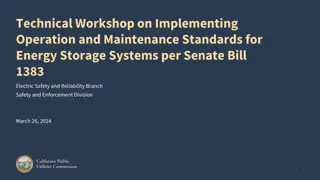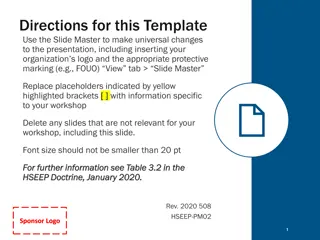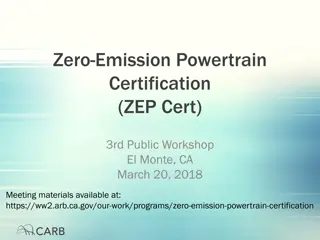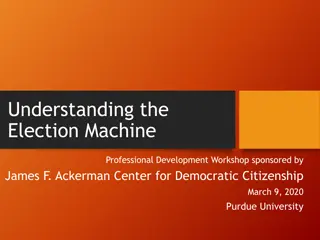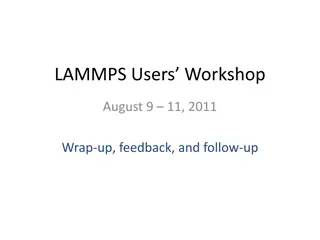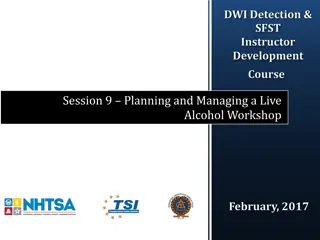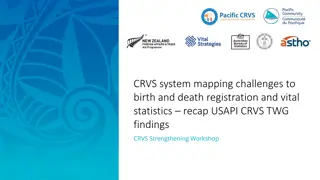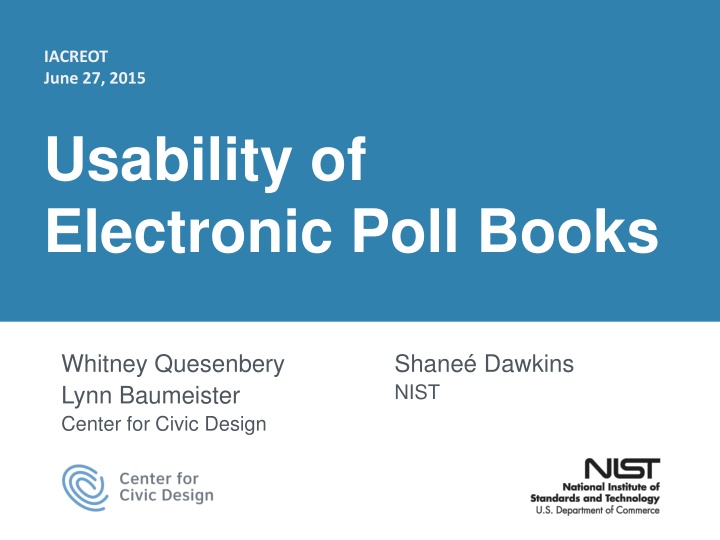
Exploring Usability of Electronic Poll Books in Elections
Discover the usability of electronic poll books in electoral processes through insightful research and findings, including interviews with election officials and surveys of current e-pollbook systems. Gain insights into the benefits, drawbacks, and legal constraints surrounding the use of e-pollbooks in various election offices and jurisdictions.
Download Presentation

Please find below an Image/Link to download the presentation.
The content on the website is provided AS IS for your information and personal use only. It may not be sold, licensed, or shared on other websites without obtaining consent from the author. If you encounter any issues during the download, it is possible that the publisher has removed the file from their server.
You are allowed to download the files provided on this website for personal or commercial use, subject to the condition that they are used lawfully. All files are the property of their respective owners.
The content on the website is provided AS IS for your information and personal use only. It may not be sold, licensed, or shared on other websites without obtaining consent from the author.
E N D
Presentation Transcript
IACREOT June 27, 2015 Usability of Electronic Poll Books Whitney Quesenbery Lynn Baumeister Center for Civic Design Shane Dawkins NIST
Introductions Who is here today?
Background About the project
Goals for the project Understand current e-pollbooks Capabilities and use in elections How they affect the polling place Look specifically at usability How poll workers use them How they help poll workers serve voters Training required
Survey of current e-pollbooks Fact finding interviews election officials in 22 states or counties Who use e-pollbooks Or were considering them Demos and reviews of 13 systems 11 commercial e-pollbooks 2 e-pollbooks built by election officials
Election Offices Colorado Connecticut District of Columbia Georgia Indiana and VSTOP Maryland Michigan Minnesota New Jersey Ohio Wisconsin Virginia Wyoming Austin, Texas Cook County, Illinois Fulton, Pennsylvania Minneapolis MN Nevada County, CA St. Louis County, MO
E-Pollbooks Robis Elections Ask ED Pollbook VR Systems EVid ES&S ExpressPoll Votec VoteSafe Scytl/SOE Clarity ePollBook EA EA Tablet EasyVote EasyPollbook DemTech Plexus KnowINK PollPad Tenex Pollbook EveryoneCounts eLect Michigan Utah
We heard about: constraints, benefits, and drawbacks Legal constraints on use Benefits Drawbacks
E-pollbooks in elections code Status Language in the election code Prohibited Language explicitly prohibits the use of electronic poll books, or includes language that effectively disallows them. Neutral There is no language or procedures in the code that cannot be done with an electronic poll book. Allowed Explicit language allowing EPBs or specifying procedures for their use.
State certification or approval Requirements Description No requirements No requirements in the state election code. Counties may choose to use electronic poll books or not. Data compatibility Requires only compatibility with the state voter registration format Certification EPBs must be approved through a state certification process. Examples: Indiana has a full certification process conducted by the state with an advisory program (VSTOP) at Ball State University Ohio has an approval process conducted by a state board The state approves vendors and products from which counties may select, or approves products on a case-by-case basis, but without a formal certification process. Approval
State may require specific e-pollbooks Requirements Description Single system The entire state uses a single product. Local elections offices are either required to use it, or must use it if they use an EPB Michigan and Utah have a system managed by the state Department of Elections Colorado s Uniform Voting System will include an electronic poll book EPB as part of a voting system The EPB is a component in a state-wide voting system. Some voting systems create a voter access card (or similar technology) that activates the voting session, and which updates an electronic voter list. Maryland and Georgia have a single voting system for the entire state which includes an electronic poll book
Benefits Drawbacks Accuracy at the polling place Faster voter check-in Connected e-pollbooks enable vote centers New technology in election administration Challenges to poll worker acceptance of new technology in the polling place Cost
What do e-pollbooks do? Summary of the landscape analysis
What is an e-pollbook (physically)? Hardware Variations Device Laptop (usually Windows) Tablet (Windows, Android, iPad, iPad mini) Operating system Windows, Windows 7, Windows 8 Android, iOS (Apple) Scanner for ID External, or tablet camera Signature capture External device, or tablet screen Case or stand Wide variety of custom cases and stands Printer Small label printer (often Brother), may be bluetooth Other Link to printer for ballot-on-demand Mobile apps Mobile app for line management
What does an e-pollbook do? The most basic function: Check in a voter Find a voter in the database Review the voter record to confirm their identify Collect the voter s signature or other identification Issue the ballot or any authorization materials Mark the voter as having voted
What does an e-pollbook do? They also Identify the correct polling place for a misplaced voter Collect updates and new registrations electronically Synchronize with other poll books or the VR database Facilitate communicaton between office and polling place Provide instruction and scripts for poll workers Facilitate updating voter history Allow a central office to monitor polling place activity and....
Connectivity Scope Impact of ED admin EPBs synced with central Immediate ED updates (e.g., mail-in ballots, voter registration) between polling places and central Central updates (e.g., mail-in ballots, voter registration) sent to polling places Periodic voter record updates (central => EPBs) Periodic voter record updates Intermediate updates handled manually EPB updates (e.g., voter history, voter registration) sent to central (EPBs => central) None Updates handled manually
E-Pollbook election journey Election Day Post-Election Pre-Election Prepare voter registration lists Pull voter records (Transform format) Load e-pollbooks Set up access for poll workers Setup Set up system Connections Supplemental updates Closing Shut down system Final reports or reconciliation Return Collect final records from EPB Polls Open Check in voters At the Polling Place Voters in wrong location Already voted Provisional ballots Election day registrations Voter information updates Live Communication Data updates Status of polling place Messages to and from the polling place Support questions Election Reporting Election checks & audits Turnout analysis Voter history Training/Support Scripts/prompts in e-pollbook Reports and Status Turnout and lines Mid-day voter lists
Variations in connectivity Constant connectivity Less connectivity e-pollbook replaces printed rosters polling place has direct connection to state database e-pollbooks connected within a polling place e-pollbooks connected within a county on election days
E-pollbook Usability What do we need to consider
Understanding usability for e-pollbooks Usability is a measure of the effectiveness, efficiency, and satisfaction achieved by a specified set of users with a given product in the performance of specified tasks. In this case: The product is the electronic poll book The users are the poll workers The tasks are the different scenarios and associated activities
Usability: Efficiency The efficiency with which poll workers can complete both routine and unusual tasks. Can e-pollbooks speed up voter check-in and reduce lines at the polling place? Is the design optimized for the most frequent tasks? Does the design help poll workers identfy voters and special circumstances quickly? Can updates be completed in a reasonable amount of time?
Usability: Effectiveness Effectiveness is the measured by the accuracy with which poll workers can handle each voter. For example, can they: Find and identify the correct voter registration record Recognize any special conditions, such as whether they have already voted or identification requirement Take appropriate action to check the voter in or deal with any special requirements Complete any administrative procedures such as logging unusual events or updating records
Usability: Satisfaction Satisfactionis a measure of poll workers attitude towards electronic poll books. This includes both positive attitudes and by a lack of negative attitudes about them. Do poll workers believe that electronic poll books: Help them do their job well Make finding voters easy Let them check voters in quickly Help them interact with voters in a helpful way
Usability is in the details Presentation Visual hierarchy what stands out on the screen Information display data grid or human-readable Clarity or clutter Navigation Efficiency - Steps or screens to complete a common task Learnability - Access to less common tasks Work process support Labels does terminology match procedures Reminders does the interface help support tasks
Example Finding a voter How easy is it to enter a search? How many screens does it take from home to voter record? Voter Details Voter List Check-in Search Search Criteria Voter Details and Check-in List, filtered by search
Example Voter lists How easily can a poll worker find a voter in the list? Voter ID 95852348611 76654123123 54788232367 Last Name Doughtery Driver Driver First Name MI Jordan John Melinda Address 23 Chestnut, Maple 1545 Tates Drive, Br 1545 Tates Drive, Br L K Name Doughtery, Jordan 95852348611 Driver, John L Driver, Melinda K Address Voter ID 23 Chestnut, Maple 1545 Tates Drive, Berwyn 1545 Tates Drive, Berwyn 76654123123 54788232367
Example Voter status Can pollworkers easily see the status of each voter? Are the indicators easy to understand? S Name Doughtery, Jordan Driver, John L Driver, Melinda K Driver, Samantha Status ID Req'd Voted Voted Address 23 Chestnut, Maple Grove 1545 Tates Drive, Berwyn 1545 Tates Drive, Berwyn 1545 Tates Drive, Berwyn Address Name Doughtery, Jordan Driver, John L Driver, Melinda K Driver, Samantha 23 Chestnut, Maple Grove 1545 Tates Drive, Berwyn 1545 Tates Drive, Berwyn 1545 Tates Drive, Berwyn
Example Voter details Does the layout make the name easy to see Voter ID Last Name First Name Middle Name Sex DOB Address City Zip 00000000001 Doughtery Jordan Jordan Doughtery August 1, 1963 - Male 23 Chestnut, Maple Grove M 08/01/1963 123 Chestnut Maple Grove 08888
A method for testing usability Possible uses for a usability testing method: Formal test protocol Benchmarking or comparing systems Certification Informal uses of usability testing Purchase decisions Planning poll worker training
Concept: Watch and learn Simulate field conditions Observe poll workers actually using an e- pollbook to check-in voters What s easy, intuitive? What s difficult, confusing? What s the overall experience like?
A simple test setup Note-taker Poll worker 3 (or more) voters with scenarios simulate the line, rotating through the line as often as needed
The basic session repeats Repeat with 6-10 participants (acting as poll workers) Poll worker 1 Poll worker 2 Poll worker 3 Poll worker 4 ... Poll worker 5 Poll worker 6 Poll worker 7
Comparing two or more e-pollbooks? Repeat entire process for each e-pollbook being tested ... Testing EPB1 ... Testing EPB2
Scenarios Voter is registered, in correct polling place with ID variations Similar/same names Registered but in wrong place Already voted Not in database at all Updates
Include set up and shut down? The usability test can include Setting up at the beginning of election day Unpack and set up communications Morning supplemental updates Shut down at the end of election day Reports and other updates Shut down and pack up
Analyzing the data What scenarios did all poll workers complete successfully? What scenarios did most or all poll workers have problems with? How consistent are the types of problems participants had? How similar are the number of different problems each participant had? Are there differences in success scores for experienced/inexperienced/first-time participant poll workers?
Comparing e-pollbooks What differences do you see in the completion scores for common/uncommon scenarios between the epoll-books? What differences do you see in the completion scores for experienced/inexperienced/first-time participant poll workers between the e- pollbooks? If your poll workers participated twice, once on each e-pollbook, what is their subjective reaction to the e-pollbooks? Do they have a preference and why?
Can problems be minimized or fixed? Could changes in training help poll workers be more successful? Are there customizable prompts or instructions on the screen that can be improved? Is the problem in the interface design or interaction?
Workshop / Discussion What matters in e-pollbook usability
What usability issues matter to election administration? Think about these questions: What issues do you anticipate (or have you experienced) around the check-in process? What usability-related benefits do you hope for around the check-in process? Write your answers on individual pieces of paper and put them out on the table.
Share back from the groups Let's hear from everyone about the usability problems they identified. Discussion: Any issues raised at other tables that your group didn't think of?
Discussion Is the idea of a usability test for e-pollbooks useful? How might it be used? For purchase decisions? For certification? To understand training needs? As way for staff to walk through the features of a system?
Usability test scenarios
How do we test for usability Scenarios or tasks let participants use the pollbooks, while ensuring that we cover as many different situations (and usability issues) as possible. A scenario includes The potential usability issue being tested The voter situation What success or failure might be Any pollbook setup needed
Sample scenarios Registered; in correct place; ID checking variations Nickname Scenario e-pollbook setup Supporting materials This voter, at that address, is a registered voter for this polling place, and has not voted. You are: Jordan Dougherty <street address> <city> <state> <zip> You have your driver s license with you 1. Regular voter Has drivers license Materials: drivers license with scan code. You are: Andrea Manciano <street address> <city> <state> <zip> You don t have your DL with you. You have your XXX This voter, at that address, is a registered voter for this polling place 3. Regular voter Has a voter card Materials: voter card (no photo or scan code)
Sample scenarios Similar / same names, hard to spell names Nickname Scenario e-pollbook setup Supporting materials Voter is registered for this polling place The e-pollbook contains 5-10 voter records with the same last name in this polling place. One of the other voter records is Kam Miller. Materials: Do not use scanned ID Sydney Davenport Jr (DOB 1990) is registered to vote in this polling place. Sydney Davenport Sr (DOB 1960) is registered to vote in this polling place. Both Davenport s have the same address. Materials: Do not use scanned ID You are: Kim Miller <street address> <city> <state> <zip> 5. Multiple duplicate last names You are: Sidney Davenport Jr. <street address> <city> <state> <zip> Add l information: Your father (Sr.) lives at the same address and has the same name. 8. Same name, same address with Jr/Sr
Sample scenarios Voter flagged Nickname Scenario e-pollbook setup Supporting materials Voter is registered for this polling place. Voter is flagged as being required to show ID. Materials: Any photo ID Voter is registered for this polling place. Voter is flagged as needing assistance You are: <first> <last> <street address> <city> <state> <zip> You are: <first> <last> <street address> <city> <state> <zip> Add linformation: You can t stand for long periods of time; you need to be able to sit while casting your vote. 11. ID required 15. Voter marked as needing assistance
Sample scenarios In wrong place Nickname Scenario e-pollbook setup Supporting materials You are: <first> <last> <street address> <city> <state> <zip> Voter is registered for this polling place but not for this precinct You are: <first> <last> <street address> <city> <state> <zip> Voter is registered for this polling place but not for this precinct <first> <last> <street address> <city> <state> <zip> 16. Wrong table/precinct at polling place Voter is registered but not in this polling place 17. Wrong polling place


